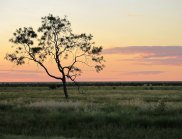New analysis promises better weed management of the Lake Eyre Basin
A team of experts developed the framework for cost-effective investment in weed management in the Lake Eyre Basin (LEB). The aim of the project was to help guide future investment in management activities for invasive species in the LEB.
Dr Jennifer Firn, project leader and Queensland University of Technology senior lecturer and visiting scientist at CSIRO’s Climate Adaptation Flagship, said substantial amounts have been invested in invasive species management to reduce negative impacts on natural assets and agricultural production in the basin.
“What is unclear is whether the invasive weed species currently being targeted represent the best investment so we brought together and a broad range of stakeholders including policy makers, managers, scientists and community representatives to find the best strategies”, Dr Firn said.
The Lake Eyre Basin covers an area the size of France, Italy and Germany combined. The basin is home to one of the largest internally draining system in the world and is rich in Indigenous culture and globally significant and endemic biodiversity.
“This work is a breakthrough in understanding how to best spend funding to maximise impact as well as identifying potentially significant co-benefits for pastoralists.”
Dr Jennifer Firn, project leader
“We conducted the first systematic decision analysis to prioritise which invasive weed management strategies are likely to achieve the greatest benefits for native biodiversity per unit cost”, said Dr Firn.
“With limited resources to manage all invasive species over the extensive range of the LEB, prioritisation is essential.”
“This work is a breakthrough in understanding how to best spend funding to maximise impact as well as identifying potentially significant co-benefits for pastoralists.”
Invasive species present a major threat to the unique native biodiversity of the Lake Eyre Basin. More than 240 invasive species have been identified across the LEB, including 20 of National Significance, including rubber vine, mother of millions and prickly acacia.
Dr Firn worked with Dr Josie Carwardine (CSIRO scientist, University of Queensland researcher) and other collaborators brought together a broad range of stakeholders including private land owners, ecologists, policy makers, NGOs and land managers to jointly identify the key invasive plant species to target and develop and evaluate different management strategies for the entire basin over a 50-year time frame.
Together they identified the key invasive plant species to target in order to protect the ecosystem across the Lake Eyre Basin, the level of investment required and the likely reduction in invasive species dominance gained per dollar spent on each strategy.
Overall, the total cost of managing 12 invasive plant strategies over the next 50 years was estimated at A$1.7 billion, which would reduce invasive plant dominance by 14 per cent (17 million ha). If only targeting Weeds of National Significance, the total cost was estimated to be A$113 million.
“Reducing the dominance of an invasive plant species and increasing native species diversity can have added benefits for many key ecosystem services including nutrient cycling, carbon sequestration, drought tolerance, hydrological flows and resilience to changing perturbations such as the ability of a plant community to recover after a fire,” said Dr Carwardine.
The research also identified a number of important co-benefits of weed control, particularly for pastoralists and Indigenous communities.
“Grazing is the major land-use in the LEB at 82 per cent of the land area,” Dr Firn said.
“Weed control is estimated to cost more than A$300 million per year in Australian livestock industries, but despite this substantial expenditure yield losses attributed to weeds continue to be more than A$1.5 billion in this industry.
Therefore investing in invasive plant control for biodiversity benefits will also have co-benefits for the livestock industry.”
Another major benefit is the opportunity for Indigenous employment, often through Indigenous rangers, for weed control.
This work is a collaboration of CSIRO, Queensland University of Technology, University of Queensland and a broad range of stakeholders including policy makers, managers, scientist and community representatives. The project was funded by the Australian Governments National Environmental Research Program (NERP) through CSIRO’s Climate Adaptation Flagship and was carried out by researchers from CSIRO, QUT and UQ Environmental Decisions Hub, with all three organisations providing in-kind support.
For more information and the full report go to: CAF Working Paper 17: Priority threat management of invasive plant species in the Lake Eyre Basin.
Media resources
Click image for high resolution version.

